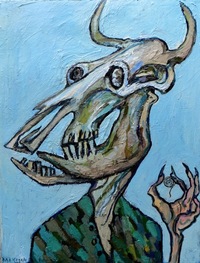Maxim Kantor Lecture on Russia Rescheduled for March 17

Maxim Kantor’s lecture on Russia has been rescheduled for Tuesday, March 17 at 4:00 pm in 114 Pasquerilla Center to allow all those interested in this topic the opportunity to participate in this week’s activities in memory of Rev. Theodore M. Hesburgh, C.S.C.
Maxim Kantor, renowned Russian artist and Director’s Fellow at the NDIAS this semester, will now give his public lecture entitled, “Russia: Empire Upside Down” on Tuesday, March 17 at 4:00 p.m. in 114 Pasquerilla Center.
Vittorio Hösle, The Paul G. Kimball Chair in Arts and Letters and Founding Director of the NDIAS, will follow Maxim’s lecture with his own remarks.
Maxim Kantor Biography
Maxim Kantor, a Russian artist of international acclaim, well-known as a painter, sculptor, novelist, playwright, and essayist, has been awarded a Director’s Fellowship for spring 2015. While in residence at the Notre Dame Institute for Advanced Study this semester, he is committed to painting many significant works as well as lecturing on the state of democracy and art in Russia. In addition to his appointment at Notre Dame, Maxim Kantor is an Honorary Fellow of the University of Oxford’s Pembroke College as well as a member of Oxford’s Senior Council for St. Antony College and Wolfson College.

The son of noted Soviet art historian and philosopher Karl Kantor, Maxim established himself with paintings that did not fit with the socialist realism of the Soviet regime, making it difficult for him to start his career. In 1977, Kantor organized the independent group of painters known as Krasny Dom (Red House) that sponsored exhibitions of the Moscow underground, the most resounding of which took place in 1982 at the Moscow Institute of Philosophy. Soon after he was discovered by Western art critics and became influential in Russia and other countries. A recurring feature of his work is his rejection of formalism in the visual arts, which he regards as a flight from moral responsibility. His art is deeply humanistic and frequently focuses on human suffering and the opportunity to overcome it through solidarity and love. Another characteristic of his art is that it is often keenly observant and sharply political. While perhaps best known for his large cycles of big oil paintings, he has also created three great portfolios of etchings and prints since 2000—Wasteland. Atlas (2001), Metropolis. Atlas (2004), and Vulcanus. Atlas (2010)—that offer a moral interpretation of the most momentous political changes of the twentieth century. His work is featured in galleries and museums worldwide, from Moscow to London to Canberra as well as in the University of Notre Dame’s Snite Museum of Art and at the Vatican.
Emerging as a talented novelist and essayist in 1993 with the publication of House in No-Man’s Land, Kantor went on to win the Russian National Literature Award in 2006 for his novel Drawing Textbook. Kantor’s critical essay collection Democracy Slow Jaws (2008) followed, focusing on the evolution and historical ideals of democracy, imperialism, human rights, totalitarianism, “democratic war,” and the development of democratic society. A year later Kantor published the novel A Contre-Pied (2009) that confronted the discrediting of liberal doctrine. Recently, Kantor has published the novel Red Light (2013), which was shortlisted for multiple Russian literary awards, and Empire Upside Down (2015). His writing also extends to a collection of satirical plays entitled An Evening with a Baboon (2007) and Robin Hood and Spiritual Buckles (2014), the latter of which was designed and written for a puppet theatre of Maxim’s own creation. It is also noteworthy that in 2013 Kantor founded the independent publishing house Robin Hood.
Originally published by Grant Osborn ’06, ’09M.F.A. at ndias.nd.edu on March 02, 2015.